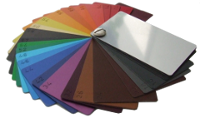Microelectronics • System software
Anodising guide - 1. What is "anodising"? |
Anodizing is the process of generating a strong oxide layer with a electrolytic bath on aluminum and many of its alloys. Special procedures also lead to a similar layer in titanium whereas other metals (iron, copper, etc.) cannot be anodised.
 In a first step the surface is built up to a certain porous thickness in an electrochemical process. After
anodising these pores are closed by so-called sealing and the chemical intermediate form is converted
into its final structure. By dyeing the component before sealing (with special anodising dye), the dye
molecules are deposited into the pores and sealed with them.
By additional use of special color pastes scratch-resistant, multi-colored surfaces can be created.
In a first step the surface is built up to a certain porous thickness in an electrochemical process. After
anodising these pores are closed by so-called sealing and the chemical intermediate form is converted
into its final structure. By dyeing the component before sealing (with special anodising dye), the dye
molecules are deposited into the pores and sealed with them.
By additional use of special color pastes scratch-resistant, multi-colored surfaces can be created.
The resulting anodic coating is very strong and resistant to many chemical substances. Additionally the aluminium parts get a refined, expensive look. Unlike conventional coatings anodized layers cannot peel off, because they grow out of the aluminum surface and are intimately connected to it. Recycling of anodized and colored aluminum layers is not problematic because the anodized coating is very thin and deposits as a surface slag in the furnace. So last but not least anodizing is a very environmentally friendly form of surface finishing.